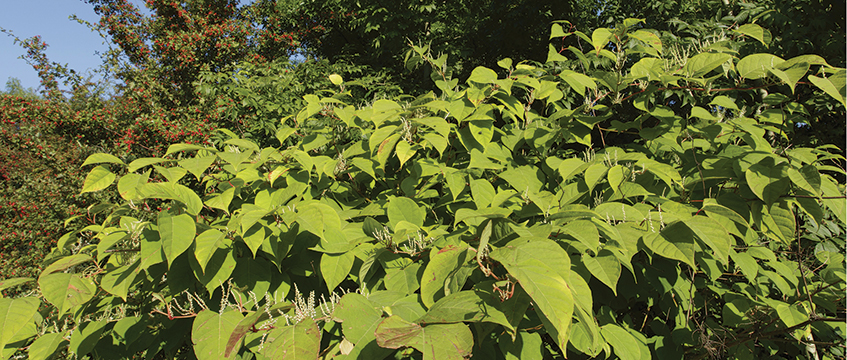Philip Santo explains a draft RICS guidance note, currently undergoing consultation, which introduces a new approach for valuers with regard to the invasive plant.
RICS has recently published a draft guidance note, Japanese knotweed and residential property, for public consultation as a proposed successor to its 2012 information paper of the same name. The key purpose of the guidance note is to ensure that valuers continue reporting objectively and consistently to lenders when Japanese knotweed is encountered during a mortgage valuation inspection.
The 2012 information paper was a response to residential sales being increasingly affected by uncertainty about Japanese knotweed. It introduced a procedure which has since ensured that most affected properties have a practical route through to mortgage finance. Since then the world of Japanese knotweed has moved on, and authoritative research means that the risks posed are now much better understood.
Current thinking
In 2019, the House of Commons Science and Technology Committee published a report, Japanese knotweed and the built environment, which acknowledged the role of RICS in ensuring that lenders have the confidence to lend against properties affected by Japanese knotweed. However, the so-called “seven-metre rule”, introduced in 2012, was described as a blunt instrument and the committee called for “a much more nuanced and evidence-based” approach.
Responding to the same House of Commons committee, a report published in 2020 on behalf of the Department for Environment, Food and Rural Affairs concluded that, within the UK housing market, beliefs about the effects of Japanese knotweed “are exaggerated, creating nervousness among buyers, sellers and lenders”, adding that “the media, and as a result the public, have a disproportionate fear of the problem”.
The Defra report advocated revision of the 2012 RICS risk categories but recommended that Japanese knotweed should be reframed as a mitigatable environmental issue, rather than solely as a property or social issue. Referencing the increasing awareness that eradication of Japanese knotweed is an unhelpful objective, the report called instead for a focus on management and control.
The new approach
The draft guidance note proposes a completely new process for valuers and surveyors to carry out a structured assessment, leading to an objective categorisation of any given infestation. The process utilises a decision tree, with detailed accompanying notes as an integral part of the assessment. The notes define and clarify elements of the decision tree, helping the user to place the property being inspected in an appropriate management category.
For all its limitations, the “seven-metre rule” is straightforward to apply, and it was considered important to retain similar simplicity for the new assessment process.
Instead of basing the assessment on distance from buildings or boundaries, the new process will reflect the actual impact that an infestation is having.
When Japanese knotweed is identified on-site, the valuer or surveyor responds to the following decision points:
- If an infestation has caused visible damage to a structure, it is assessed as Management Category A: Action.
- If structural damage is not visible but an infestation is likely to prevent use of or restrict access to amenity space, the assessment is Management Category B: Action.
- If growth is simply present on-site but not causing damage or affecting amenity space then it falls into Management Category C: Manage.
Each category has specific reporting recommendations.
Infestations seen beyond the boundaries of the subject property are only given a formal category if they are within three metres of the boundary – Management Category D: Report. Anything beyond three metres is not formally categorised or reported to lenders, although valuers and surveyors should still keep appropriate records in their site notes.
Although the assessment process is primarily intended for providing advice to lending institutions, it also supports the full range of residential inspections and surveys carried out by RICS members, so the guidance note includes advice on reporting to private clients. Once established, this new framework can be flexibly utilised by all stakeholders to suit their own business objectives.
There is also advice about valuing residential properties affected by Japanese knotweed. The note describes the problems faced by valuers, partly owing to the market perception of Japanese knotweed but also because the impact of infestations on value can vary significantly, depending on a variety of circumstances.
It warns that applying a “standard percentage reduction” or only deducting remediation costs from an agreed purchase price are not appropriate valuation approaches and briefly summarises a range of factors that may need to be considered.
Conscious that the readership of the guidance will be far wider than RICS members, the early sections include explanations about the varying responsibilities of valuers and surveyors, depending on the type of inspection being undertaken.
Perhaps more importantly, having this baseline summary of responsibilities in relation to inspections and Japanese knotweed within a single document should prove helpful during future legal proceedings.
Further guidance
In contrast to the previous information paper, there is only limited information about remediation options and there is nothing about identifying Japanese knotweed.
Working very closely with RICS, the Property Care Association has issued a very informative paper, Japanese Knotweed – Guidance for Professional Valuers and Surveyors, to complement the RICS guidance note. It deals in depth with these and other topics. Ongoing research and other developments will probably mean modifying remediation strategies at times so the PCA paper can be updated as required, while valuers’ initial guidance for lenders remains unchanged.
The consultation on the draft RICS guidance note is open to all until 3 August 2021. It is anticipated that the final guidance note will be published during the autumn, coming into effect by the end of the year.
Philip Santo FRICS is a director at Philip Santo & Co and technical author of the guidance note








